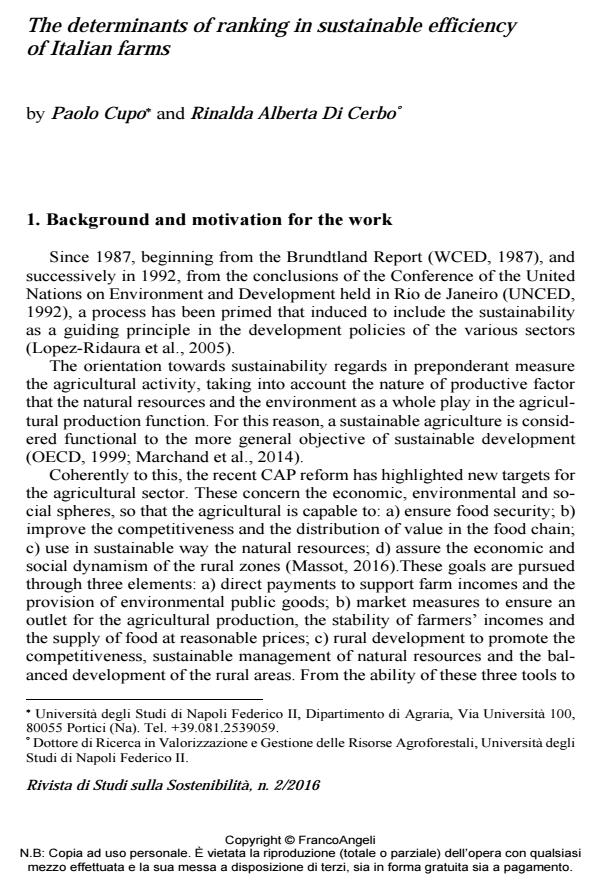The determinants of ranking in sustainable efficiency of Italian farms
Titolo Rivista RIVISTA DI STUDI SULLA SOSTENIBILITA'
Autori/Curatori Paolo Cupo, Rinalda Alberta Di Cerbo
Anno di pubblicazione 2017 Fascicolo 2016/2
Lingua Inglese Numero pagine 19 P. 141-159 Dimensione file 347 KB
DOI 10.3280/RISS2016-002013
Il DOI è il codice a barre della proprietà intellettuale: per saperne di più
clicca qui
Qui sotto puoi vedere in anteprima la prima pagina di questo articolo.
Se questo articolo ti interessa, lo puoi acquistare (e scaricare in formato pdf) seguendo le facili indicazioni per acquistare il download credit. Acquista Download Credits per scaricare questo Articolo in formato PDF

FrancoAngeli è membro della Publishers International Linking Association, Inc (PILA)associazione indipendente e non profit per facilitare (attraverso i servizi tecnologici implementati da CrossRef.org) l’accesso degli studiosi ai contenuti digitali nelle pubblicazioni professionali e scientifiche
This study individuates the determinates of the farms’ sustainability following the approach based on the concept of sustainable value formulated by Figge and Hann (2004), which integrates the environmental, economic and social components into a single monetary indicator that takes into account the opportunity cost of the resources used defined by a benchmark. The results of the GLM regression show that almost all the structural characteristics have a significant impact on the sustainable efficiency of the farms, while the specialized farms perform better than mixed farms like the young and male farmers. Moreover, the highly significant and positive coefficients of correlation between the three components of sustainability, demonstrate that no trade-off exists between them.
Questo studio individua i fattori che determinano la sostenibilità delle aziende agricole seguendo l’approccio basato sul concetto di valore sostenibile formulato da Figge e Hann (2004), che integra le componenti ambientali, economiche e sociali in un unico indicatore monetario che considera il costo opportunità delle risorse utilizzate definito da un benchmark. I risultati di un modello GLM mostrano che quasi tutte le caratteristiche strutturali hanno un impatto significativo sull’efficienza sostenibile delle aziende agricole, mentre le aziende specializzate hanno performance migliori rispetto aziende miste, come la giovane età ed il sesso maschile degli imprenditori. Inoltre, l’analisi di correlazione evidenzia che tra le tre componenti della sostenibilità non esiste alcun trade-off.
Parole chiave:Sostenibilità, efficienza, classificazione, capitale, costo opportunità, soglia di riferimento.
- INTERDEPENDENCE OF ECONOMIC AND ENVIRONMENTAL EFFICIENCY IN AGRICULTURE IN THE EUROPEAN UNION Jakub Staniszewski, Andrzej Czyżewski, in Acta Scientiarum Polonorum. Oeconomia /2018 pp.159
DOI: 10.22630/ASPE.2018.17.4.63
Paolo Cupo, Rinalda Alberta Di Cerbo, The determinants of ranking in sustainable efficiency of Italian farms in "RIVISTA DI STUDI SULLA SOSTENIBILITA'" 2/2016, pp 141-159, DOI: 10.3280/RISS2016-002013